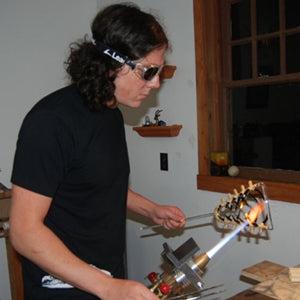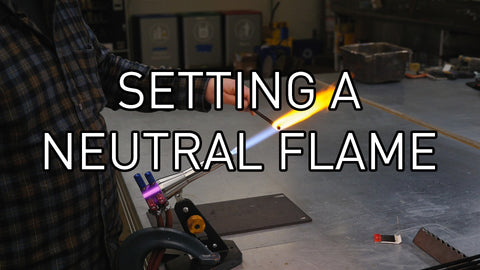Glass Blowing: An Introduction to Modern Lampworking

When I tell people I make glass, they generally think of soft glass, more specifically, they think about off-hand soft glass work. This is totally understandable given that glass blowing has a very long history, going back thousands of years.
I will then explain the difference between soft glass and boro. Once someone understands the difference between the types of glasses, I then get to explain the difference between the off-hand approach to glass blowing and the lampworking approach.
If you are new to glass, this is a lot of information to take in and most people find it fascinating – because it is! So, while glass blowing and lampworking have both been around for a long time, lampworking borosilicate glass, or what I like to call Modern Lampworking, is relatively new.
So What is Lampworking?
As borosilicate lampworkers, we can trace our roots back to the development of clear borosilicate glass by Otto Schott in the late 19th century. The scientific glass blowing techniques that developed since then, combined with the artistic approach from the soft glass world, helped create a whole new approach to glass blowing, using a high temperature torch.
Since the creation of the Glass Alchemy color palette, we have seen an explosion in modern lampworking over the past 20 years. Today’s color selection by Glass Alchemy, tools and artistic talent have led to the creation of amazing museum quality art work.
What do you need to get started?
If you want to get started in glass blowing, you will need a few key pieces of equipment.
My studio is set up; now how do I learn glass blowing?
Now that you have a bench space set up, ventilation in place and a nice stock of GA color, you are ready to start blowing glass!! Now, don’t let people tell you that lampworking isn’t glass blowing. It is!! I have seriously had people try and argue with me about this. I have even see articles on the internet about glass blowing that say lampworking is not technically the same things as glass blowing, since you don’t blow air in to the glass. What?! While lampworking doesn’t always require air to manipulate the hot glass, we regularly use blow tubes, do blow ins and use air in a variety of other ways.
When you first get started, I strongly suggest you take a class or get some torch time at a local studio where someone can help give you pointers. But beware, there is a lot of misinformation out there
Glass Alchemy glass blowing tutorials
There is an incredible amount of information out there to help you learn the ins-and-outs of glass blowing. As I mentioned, there is also a lot of misinformation out there when it comes to working colors. Since each color is made with a different chemical composition, each color behaves slightly differently, and each colorant has rules written by mother nature that we must follow for the glass to keep the COE of 33.
I have a series on our YouTube channel which addresses some of the most frequently asked questions we get here at Glass Alchemy.
Once you get your torch fired up, I recommend you learn more about a neutral flame. By learning how to set a neutral flame, you will save yourself a lot of frustration and will set yourself up for achieving color success. You can check out my Neutral Flame video here.
Be sure to subscribe to the Glass Alchemy YouTube channel so you can catch all our tutorials.
Peace - Thomas



1 comment
VERY USEFUL